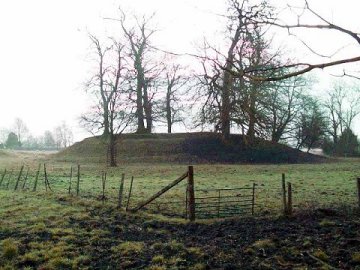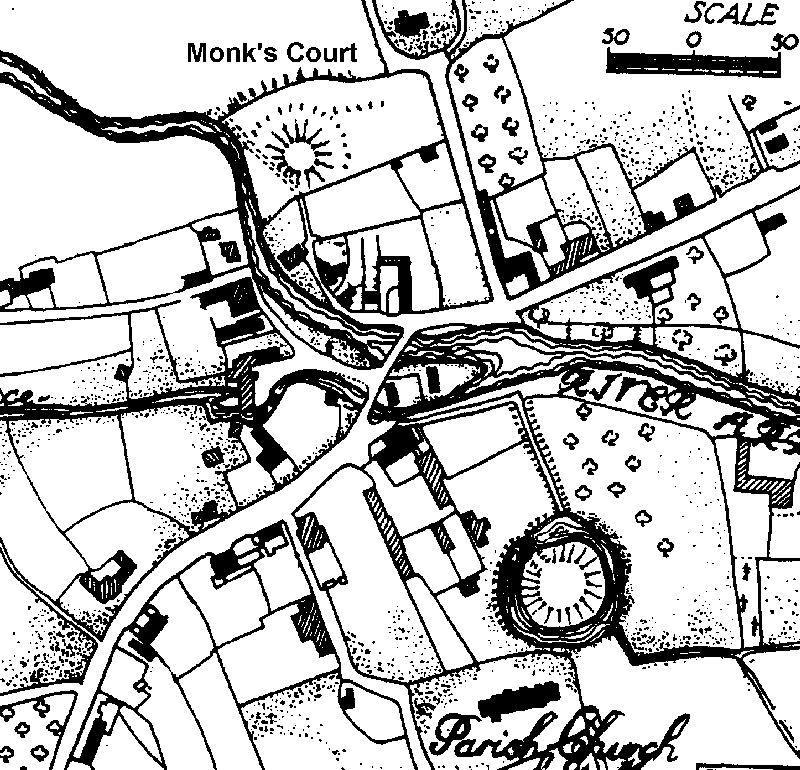Kingsland, Eardisland and Monk’s Court Castles
Neither Kingsland or Eardisland castles are mentioned in the eleventh or twelfth centuries. This however, does not mean that they did not exist. Both castles stood in the ancient Herefordshire district of Leon which is preserved in their own and other placenames. Since Domesday the etymology of these places which end in Lene have been mis-translated to represent 'land'. Originally it appears to have stood for Leon, the early name of the district between the rivers Arrow and Lugg. This has also given the first elements in the names of Lyonshall and Leominster.
The two castles of Kingsland and Eardisland make their only foray into historical records at the beginning of the thirteenth century. On 28 May 1213, King John ordered William Cantilupe, his lord of Wilton castle in Herefordshire, to munition the castles of Hereford and Hordiand. It is possible that the later site referred to is our first mention of a castle at Eardisland. If this is so we can see that the castle was in the king’s hands as it had been seized from William Braose after his rebellion in 1208. During the subsequent invasion of England by the French, King John retreated to the Marches of Wales and between 2 and 3 August 1216 he stayed at Kingsland during his harrying campaign against the remaining Braoses. Quite possibly he would have destroyed any fortifications at both places as was certainly the case with the nearby Braose castles of Radnor and Hay on Wye. Certainly neither Kingsland or Eardisland was ever mentioned again as a fortress.
Reginald Braose received his hereditary lands in Herefordshire back in 1217 and the next mention of both places suggests that they were no longer considered as containing fortresses. On 25 April 1230 the king granted the lands and castles of Reginald's son and heir William Braose (ex.1230) to William Marshall. These consisted of the castles of Totnes, Huntington, Ystradfellte (Stratmelthin), Hay on Wye, Brecon, Radnor, St Clears and most interestingly ‘the bails of’ Kingsland (Kingeslen) and Eardisland (Erleslen). This strongly suggests that the last two were held on different terms to the Braose's other lands. They were probably held directly by royal grant and it also implies that they were no longer castles, now merely being ‘bails’. Although both places are mentioned subsequently they are never treated as fortifications as Eardisland apparently was in 1213.
Kingsland Castle

Eardisland Castle
All that remains above ground of Eardisland castle is the impressive conical motte, still surrounded by an impressive wet moat. All trace of the castle bailey or baileys have now disappeared, but they were probably extensive like those around Kingsland castle. On the now inaccessible motte top are the overgrown remains of foundations of another shell keep. This one appears about seventy feet in diameter and was probably similar to those found at Kingsland and Aston castles. There was once a causeway over the moat to the motte, but this has been grubbed up in recent times.

Monk’s Court Castle
On the opposite side of the River Arrow to Eardisland castle stands the diminutive Monk’s Court castle. This is very similar to the siege castle at Aston No.2. It consists of a low, five feet high mound with a motte top of about 65 feet in diameter. This was surrounded by a wet ditch which is now mostly silted up. A rectangular bailey lay to the east. Like Aston No.2 this structure is best seen as a siege castle to the nearby stone-fortified motte of Eardisland castle. Without any recorded history it is probably best to ascribe this castle to the period of the Anarchy and list it amongst the very precise figure of 1,115 castles said to have been destroyed by King Henry II on his assuming the English crown. If Monk’s Court is a Stephanic siege castle then it proves the existence of Eardisland castle before that date. Any siege here would probably date to either King Stephen’s Little Hereford campaign, or the attack made by Hugh Mortimer against Earl Roger of Hereford between 1144 and 1148. In both cases the occupiers of the castle would probably have been either Earl Roger or his father Earl Miles Gloucester of Hereford (d.1143)